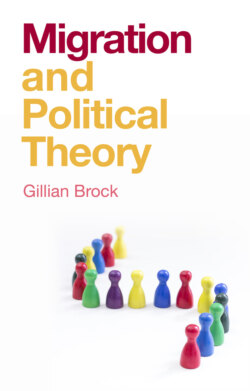Читать книгу Migration and Political Theory - Gillian Brock - Страница 7
1 Introduction
ОглавлениеMigration issues dominate contemporary political discourse, and there has been a matching surge in political theorizing about the complex issues that migration raises. President Trump promised to build a wall on the United States’ southern border with Mexico (and to get Mexico to pay for it). He also promised to end the green card lottery, suspend refugee programs, force Dreamers to leave the United States, and deport more of those living illegally in the United States than ever before. The successful campaign for Britain to leave the European Union invoked much fear concerning rising numbers of immigrants. Australia, Italy, and Greece vigilantly guard their coasts, intercepting boats aiming to enter their waters. Violent clashes erupt in South Africa when Zimbabweans seeking work appear to threaten local job opportunities. Protecting the homeland from unwelcome foreign immigrants raises deep questions about the nature of who “we” are and what we fear about others. And it also invites us to think about several other topics, including the nature of political community, the defensible scope of self-determination, rightful authority to exclude from a territory, and the standing of borders.
The range of concerns that migration presents for those interested in matters of justice extends well beyond this cluster of issues centered on the state’s authority to exclude. Much migration is appropriately described as forced, as in the case of refugees. What responsibilities do we have to refugees seeking safe haven? And voluntary migration invokes a host of fairness concerns as well. What kinds of criteria may states permissibly use in formulating selection and citizenship policies? May states permissibly use wealth, health status, language proficiency, religion, sexual orientation, or family connections in such decisions? If so, how and when? Are there normative constraints on how destination countries may treat their “guest workers” from other countries and, if so, what are they? Does justice require regularizing the status of those who have been living in the state in ways deemed to be unlawful, at least under certain conditions? May governments ever defensibly restrict outmigration, preventing its citizens from leaving the territory, as the Soviet Union once did? These are just some of the many issues receiving considerable contemporary attention that are discussed in this work. This book aims to provide an introduction to the core of debates, along with focused attention to current and emerging questions.
This chapter provides some important background to discussing such issues. The chapter also seeks to offer some key facts about migration today in efforts to ensure readers have an accurate understanding of seminal information, which is sometimes appealed to or assumed in current debates. Sometimes politicians and citizens have important misconceptions about the nature, scope, and elements concerning migration. In such cases, arguments rest on shaky foundations. For instance, in contrast to the widely held view that movement is primarily from the so-called Global South to the Global North, in fact just as much, if not more, is South-South migration (IOM 2016). In addition, much migration is not of the kind that aims to be permanent. The phenomenon of migration certainly includes the cases of immigration and settlement, but also temporary and circular migration. This chapter also maps out some of the ethical and justice issues that migration raises and gives an overview of the book, with brief synopses of all the chapters.
The first section covers some central facts about contemporary migration. Section 1.2 explains some frequently used terms in the migration literature that are relevant to political theory. It also outlines some of the key drivers and consequences of migration. Section 1.3 covers a short history of human migration, highlighting some important moments that well illustrate some of the reasons why we have been moving about the planet from our earliest days as human beings. The fourth section provides an overview of core themes that the reader will encounter in subsequent chapters.
